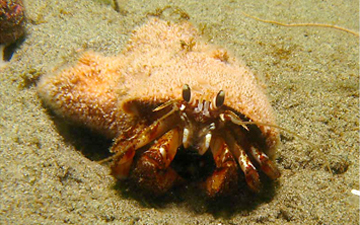Pagurus armatus, the armed hermit crab [1] or black-eyed hermit crab [3], is a species of hermit crab found in the eastern Pacific Ocean [4] of the United States and British Columbia, Canada [5].
P. armatus is one of the largest species of hermit crab [3]: adults may reach a carapace length of 43 mm (1.7 in) [6]. The legs, including the claws, have bands of colour, in red, orange and white, and the claws bear short spines on the dorsal surface [6]. The eyestalks are short, but bear large black compound eyes [6]. P. armatus can be told apart from the similar P. ochotensis by the spines on its claws, which in P. ochotensis are replaced by granules. The two species are so similar that they have sometimes been considered members of the same species, but are now generally thought to be two distinct species [2].
P. armatus lives on a variety of substrates, being particularly abundant in sea pen beds, at depths of up to 117 m (384 ft) [6].
(From Wikipedia, July 29th, 2010)
—
Hermit crabs, the tidepool entertainers, are abundant around the world among both intertidal and subtidal critters. Their soft, unprotected abdomens are asymmetrical and curved to fit the spiral shape of snail shells they live in. Hermit crabs carry their shell homes on their backs and tuck themselves away inside for protection using their strong stomach muscles. They have two sets of legs that they extend outside their shell for walking and two pairs of legs tucked away inside that they use to move their body around inside their shell. Hermit crabs are “right-handed” as their right claws are larger and usually a different shape from their left claws. They use the large right claw for protection and holding food, and the small left claw for eating.
Hermit crabs hardly ever leave their shell, but when their home gets too small they go searching for a new one. Fewer empty shells in the tidal zone means fewer homes for hermit crabs. Even when this happens though, hermit crabs will never take healthy snails out of their shells, but they are certainly good at smelling out stinky dying or dead snails in hopes of a new home.
Male hermits are often seen dragging around a female by their small claw, fiercely fighting off rival suitors with their big claw. The male will drag his potential mate around until she is ready to molt. When the female crab molts she is receptive and the male can then fertilize her eggs.
Hermit crabs are mainly scavengers and can often be seen digging for food, preying on smaller organisms, or scrounging for scraps on the ocean floor.
(From OceanLink, July 29th, 2010)





